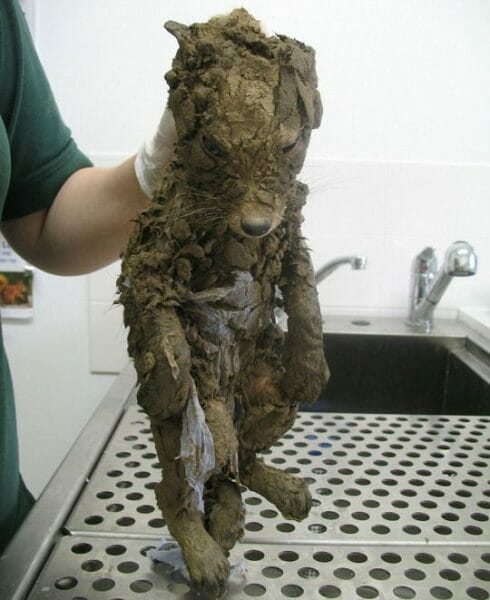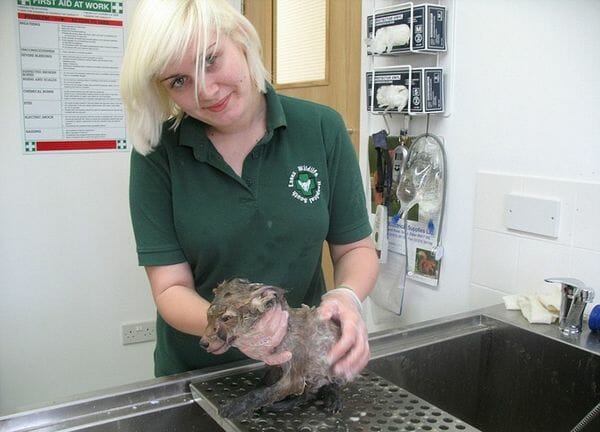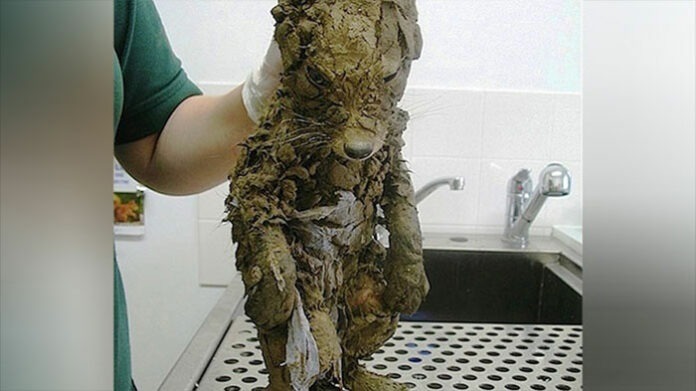A Muddy Discovery Beneath the City
It began as an ordinary day on a busy construction site at Canary Wharf, one of London’s bustling business districts. Amid the sounds of machinery and the rhythm of hammers striking steel, a group of workers noticed faint whimpers rising from a muddy hole. What they found inside stopped them in their tracks — a tiny creature, completely caked in mud and tangled in bits of plastic.
At first glance, it looked like a lost puppy struggling to breathe. But as they gently pulled the small animal free, uncertainty filled the air. Its features were hidden beneath layers of grime, and even the most seasoned workers couldn’t tell what kind of animal it was. What they did know was that it needed help — and fast.
What happened next turned a simple act of kindness into a story that captured hearts worldwide, blending science, compassion, and the timeless wonder of nature’s surprises.

The Rescue That Began with Compassion
The construction team acted quickly, wrapping the little animal in a towel and contacting the South Essex Wildlife Hospital, an organization known for rescuing and rehabilitating wild animals across the region.
When the rescue team arrived, they too were puzzled. Despite years of working with wildlife, none of them could say for sure what species the muddy creature belonged to. Only one thing was certain — it was exhausted, frightened, and in desperate need of care.
The animal was rushed to the hospital, where a group of veterinary professionals prepared for a thorough but gentle cleaning. As the mud began to rinse away, something astonishing happened: beneath the layers of muck wasn’t a dog at all — it was a four-month-old baby fox.
The workers had unknowingly rescued one of the city’s youngest urban foxes. They affectionately named him Muddsey, a fitting tribute to the unforgettable condition in which he was found.

From “Puppy” to Fox — The Science Behind the Mistake
It’s easy to see why the workers mistook Muddsey for a puppy. Young red foxes (Vulpes vulpes) share several traits with domestic dogs, especially during their early months of life. Both species belong to the Canidae family, meaning they are distant cousins with similar body shapes, facial structures, and behaviors.
However, there are subtle differences. While puppies often have rounded ears and shorter muzzles, young foxes tend to have pointier faces, longer tails, and slightly more slender bodies. In Muddsey’s case, the thick layer of mud made these distinctions impossible to see.
Urban wildlife experts note that London’s growing population of red foxes frequently leads to such confusion. These adaptable animals thrive in cities, scavenging for food and finding shelter in unexpected places — including construction sites. The combination of curiosity and survival instinct can lead young foxes to wander into dangerous areas, like the hole where Muddsey became trapped.

The Cultural and Symbolic Significance of Foxes
In cultures around the world, foxes have long carried symbolic meaning. In Japanese folklore, the fox, or kitsune, is often portrayed as a wise and mystical creature — a guardian spirit with intelligence beyond human understanding. In Celtic mythology, the fox represents cleverness and adaptability, guiding humans through unfamiliar paths with grace and insight.
Even in modern storytelling, from children’s tales to animated films, the fox remains a symbol of resilience, resourcefulness, and mystery. Muddsey’s story echoes that tradition — a reminder that even the smallest creatures can hold lessons about survival and transformation.
Where some might see only an animal, others see nature’s quiet message: that compassion bridges the gap between human progress and the wild world still thriving around us.
The Role of Wildlife Hospitals in Urban Rescue
The South Essex Wildlife Hospital, where Muddsey was treated, plays a crucial role in caring for the growing number of wild animals found in urban environments. Staffed by veterinarians and volunteers, the hospital provides emergency treatment, rehabilitation, and release programs for creatures ranging from hedgehogs to birds of prey.
When Muddsey arrived, covered in mud and plastic debris, the team carefully cleaned and warmed him, ensuring he suffered no internal injuries or infections. Within hours, his transformation was remarkable — from a frightened, unrecognizable figure to a bright-eyed, curious young fox.
Hospital manager Su Schwar praised both the workers who found him and the team who cared for him. She noted that timely action made all the difference: without the workers’ quick response and compassion, the little fox might not have survived the ordeal.
Muddsey’s recovery was swift, and after observation, he was soon ready to return to the wild — stronger, cleaner, and free once more.
Why Stories Like Muddsey’s Matter
Stories of rescue resonate deeply because they touch on universal values — empathy, responsibility, and connection. They remind us that kindness doesn’t always require grand gestures; sometimes, it’s as simple as stopping work for a moment to save a life that others might overlook.
From a psychological standpoint, humans are wired to respond to vulnerable creatures. Research from the University of Oxford suggests that seeing animals in distress activates areas of the brain associated with caregiving and emotional empathy — the same centers that prompt us to comfort a crying child.
Muddsey’s story also underscores the importance of urban wildlife awareness. As cities expand, encounters between humans and wild animals become more common. Understanding how to respond — by contacting trained rescuers instead of intervening directly — ensures that both people and animals stay safe.
A Deeper Look — Urban Foxes in Modern Ecosystems
Urban foxes are one of the most successful examples of wildlife adaptation. According to data from the London Wildlife Trust, an estimated 10,000 foxes live across Greater London, thriving in parks, gardens, and construction zones.
Their diet is incredibly flexible — consisting of insects, small mammals, fruits, and even discarded human food. This adaptability allows them to coexist with urban development, though it also leads to occasional misunderstandings.
Wildlife experts encourage coexistence rather than conflict. Foxes are generally shy and avoid humans unless cornered or seeking food. Maintaining clean environments, securing waste bins, and avoiding feeding wild animals directly helps ensure peaceful coexistence.
Muddsey’s story, therefore, isn’t just about a single rescue. It reflects a broader conversation about how cities and nature can share the same space without harm.
The Cultural Shift Toward Compassionate Coexistence
Modern society is witnessing a quiet but significant change in how people view wild animals. Once seen as nuisances or threats, they are now recognized as vital parts of the ecosystem — deserving of respect and protection.
Organizations like the Essex Wildlife Hospital, The Wildlife Trusts, and RSPCA (Royal Society for the Prevention of Cruelty to Animals) are leading the way in educating the public, rescuing animals in need, and promoting sustainable coexistence.
This shift mirrors a growing global awareness: compassion toward animals reflects the best of human values. Whether it’s a firefighter saving a chihuahua from a burning building or construction workers rescuing a muddy fox cub, these moments remind us that empathy knows no boundaries of species or size.

A Happy Ending and a Lasting Message
After his recovery, Muddsey was released back into a safe woodland area — where he could rediscover his instincts and live as nature intended. The construction crew who found him reportedly kept in touch with the wildlife hospital, eager to hear updates about the little fox who had briefly become their honorary co-worker.
For everyone involved, it was more than just a rescue. It was a moment that bridged the divide between human development and nature’s resilience. A reminder that every act of kindness, no matter how small, contributes to a world where compassion guides our progress.
Conclusion: Curiosity, Kindness, and the Unexpected Wonders of Nature
When the workers first heard those faint cries from the muddy pit, they couldn’t have imagined the story that would unfold. What began as a simple act of rescue revealed the remarkable adaptability of wildlife and the depth of human empathy.
In a world often focused on speed and construction, Muddsey’s story slows us down — inviting us to look closer, to listen, and to care. It reminds us that life, in all its forms, deserves a chance to be seen, saved, and celebrated.
Because sometimes, the most extraordinary discoveries come from the most ordinary days — when compassion meets curiosity, and the result is a miracle covered in mud.
Sources
-
South Essex Wildlife Hospital – Official Updates and Rescue Reports
-
London Wildlife Trust – Urban Fox Facts and Data
-
Royal Society for the Prevention of Cruelty to Animals (RSPCA) – Wildlife Rescue Guidelines
-
University of Oxford – The Science of Human Empathy
-
secbuzz.com – Construction Workers Find Puppy Caked in Mud, Vet Said, “He’s Not a Dog” At All
